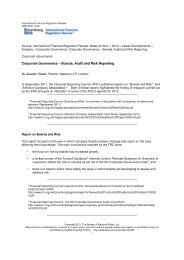2012 - Challenging times? Real Estate - Nabarro
2012 - Challenging times? Real Estate - Nabarro
2012 - Challenging times? Real Estate - Nabarro
Create successful ePaper yourself
Turn your PDF publications into a flip-book with our unique Google optimized e-Paper software.
2011 saw international investors snap up prime London assets. Problemsin the Eurozone, a scarcity of bank finance, low economic confidence andGovernment spending cuts all present a conundrum for <strong>2012</strong>.This year will undoubtedly be challenging and uncertain but by analysingsome of our recent activity we believe some of the answers and continuingtrends in <strong>2012</strong> can be found.LondonLondon comprises a number of different markets and looks likely to remain a key target for domestic andinternational investment as well as selected development opportunities.City: 2011 was a busy year for City investment which finished with alandmark transaction for <strong>Nabarro</strong>. We advised Blackrock UK PropertyFund, Hermes Property Unit Trust and LaSalle Investment Managementon the sale of iconic Tower 42, one of the tallest City buildings for£282.5m. We also acted for Mitsubishi <strong>Estate</strong> on its purchase of 6-8Bishopsgate and 150 Leadenhall Street; Hammerson on its disposal of60 Threadneedle Street for a sum of in excess of £176m; and AXA REIMon its c£200m acquisition of 20 Gresham Street.City development also continues. We represented Mitsui Fudosan on itsacquisition of sites in Moorgate and Mark Lane near Tower Bridge andwe continue to see joint ventures such as Land Securities co-venturewith Canary Wharf Group for the “Walkie Talkie” at 20 Fenchurch Street.West End: Crossrail construction is now well underway with significantsites at Tottenham Court Road and Holborn providing impetus toregeneration. During 2011, <strong>Nabarro</strong> acted for long-standing client, GreatPortland <strong>Estate</strong>s on its £120m acquisition of a major 2.3 acre freeholdsite between Rathbone Place and Newman Street. The West End sitewill be redeveloped to create a mixed-use development which willcontribute to the renewed vibrancy of the eastern end of Oxford Streetbordering on Midtown.Midtown: Continues its renaissance, expanding on the traditional legaland financial services occupier base with progressive media andtechnology companies and consolidating a reputation for great newbuildings and revived places. Recently, <strong>Nabarro</strong> acted for Frogmore in itsacquisition of a 25 per cent interest in Centre Point; this iconic buildingowned by Almacantar and sitting on the key hub between Oxford Streetand Covent Garden, immediately above the new Crossrail station, isdestined for a total transformation. We have also been active in thisarea with Frogmore/Land Securities on the natural extension to primeOxford Street.We also acted for The Great Ropemaker Partnership, a joint venturebetween Great Portland <strong>Estate</strong>s and BP Pension Fund on its £132.75macquisition of 200 & 214 Gray’s Inn Road which is let to tenantsincluding Carlton Communications and ITN.Tower 42, LondonCentre Point, LondonWill London lead the field?
Double dip, recovery or flat?Investment OutlookActivity in <strong>2012</strong> will inevitably be influenced bythe economy, the Eurozone, debt availabilityand world events.In December 2011, we published the results of ourlatest Fund trends survey which asked UK andoverseas sovereign, institutional, corporate andprivate wealth funds to predict <strong>2012</strong> real estateactivity. As the graph shows, London offices areexpected to remain the UK destination of choice forinvestment but other sectors will also attract interest.By way of example, the survey also reveals thatout-of-town retail and in-town retail is the secondmost popular UK real estate asset class. The recordretail trade over the Christmas 2011 period couldgalvanise interest in the real estate sector for <strong>2012</strong>.The Government continues to try to stimulate theeconomy through a range of measures includingquantitative easing. In addition, increasedGovernment spending on infrastructure and othercapital projects should also eventually encourageprivate sector activity.Percentage of respondents who selected each of the sectors listedas one of the two sectors they consider to be most popular for realestate investment in the UK in 2011/12Offices – LondonRetail – out-of-townMezzanine realestate financeRetail – in-townStudentaccommodationIndustrial anddistribution11.4%7.5%8.5%24.5%22.5%19%14.2%23.8%15%<strong>Nabarro</strong>’s Fund trends survey 2011/12042.6%68.9%Investor83.8%Fund Manager20 40 60 80 100RetailRetail assets will continue to require active management in<strong>2012</strong>. Restructuring, payment plans and rent concessions willbe issues for landlords as well as tenants going under orwishing to continue to trade from certain stores whilstabandoning others.Just before Christmas 2011, Mary Portas issued her report on thestate of retailing on the local high street. It made bleak readingand highlights the challenges for the high street as well as settingout proposals to help.During 2011, we represented fund client Brockton Capital, on theacquisition of The Mailbox, a new retail and leisure developmenton a former Royal Mail site in Birmingham. Retail was one of thefew real estate sectors outside London with activity outstrippingdemand for regional offices.The Mailbox, Birmingham“We have earmarked substantial funds to enhance The Mailbox in order to further improve the public realm, bring innew businesses, shops, restaurants and other leisure uses to the asset and further cement its reputation as one of thebest places in Birmingham to work, eat, shop and relax.” David Zimmermann, Brockton Capital<strong>Nabarro</strong> also represented Hammerson on its acquisition of approximately 1.25m square feet of retail space from StMartin’s Property Investments, comprising four shopping centres for around £298m.Retail: will the high street survive?
Lend or enforce? What will the banks do?DebtWe expect the debt drought to continue in <strong>2012</strong>. Regulatory changes will also have an effect on debt availability andrefinancing. Some lenders are leaving the market or lending on reduced loan to value rates. Other financeproviders, such as insurance companies facing a more benign regulatory regime, may step in to help fill the gapand lend in <strong>2012</strong>.However, debt continues to be obtainable for the right assets and borrowers. During the last quarter of 2011, <strong>Nabarro</strong>acted for long standing clients SEGRO and Aviva Investors on the refinancing of their Airport Property Partnershipindustrial portfolio. This comprised a package of £400m of senior debt provided by a consortium of banks led by HSBC,Barclays, RBS, BNP Paribas, Credit Agricole and Santander.“We are delighted to have secured five-year funding with a strong group of banks. We now have a secure fundingplatform in place and working with our partners Aviva Investors, we will seek to drive even greater value from the jointventure. In particular, we will continue to exploit opportunities from the attractive Heathrow market.”Alan Holland, SEGROThere are reports of at least £100bn of debt to be refinanced during <strong>2012</strong>. We expect an increasing number ofenforcements and debt portfolio transactions.Investment trends: the UK ParadoxTo justify the risks of ownership, the oldrule of thumb was that property needed toprovide a yield premium over GovernmentDebt (Gilts) of about two per cent.Quantitative Easing (QE) has resulted inGilt yields falling to historic lows andcreating the perception that property ischeap by comparison. The chart looks atthe relationships between UK real estateand fixed income debt.<strong>Real</strong> Capital Analytics, similar to IPD,provides a property transactional basedmeasure of initial yields. The blue linelooks at the difference between the upperquartile property yields (so-calledsecondary property) and the yield on the10 year Gilt. The red line does the same forsimilarly defined prime property. Bothshow real estate in an attractive lightagainst gilts, but how much of that is theQE effect? The purple and green linescompare prime and secondary property,Category6%5%4%3%2%1%0%-1%AEW UKQ32008Q42008but this time against corporate bond yields using iBoxx bond market indices which measure high and low credit ratedbonds. It’s striking how less favourable the price comparison is on this measure. Of course, it’s easy to criticise thiscomparison as the historical period is short and real estate is a real asset that comes with some inflation protection.“For a value manager like AEW, finding assets that have the income profile of prime assets but have been priced as if theywere more risky, secondary assets is the real win in long term relative performance.” Richard Tanner, AEW UKQ12009Q22009Q32009Q42009Q12010Q22010Q32010Q42010Q12011Q22011Q32011Q42011Can the Euro survive?











